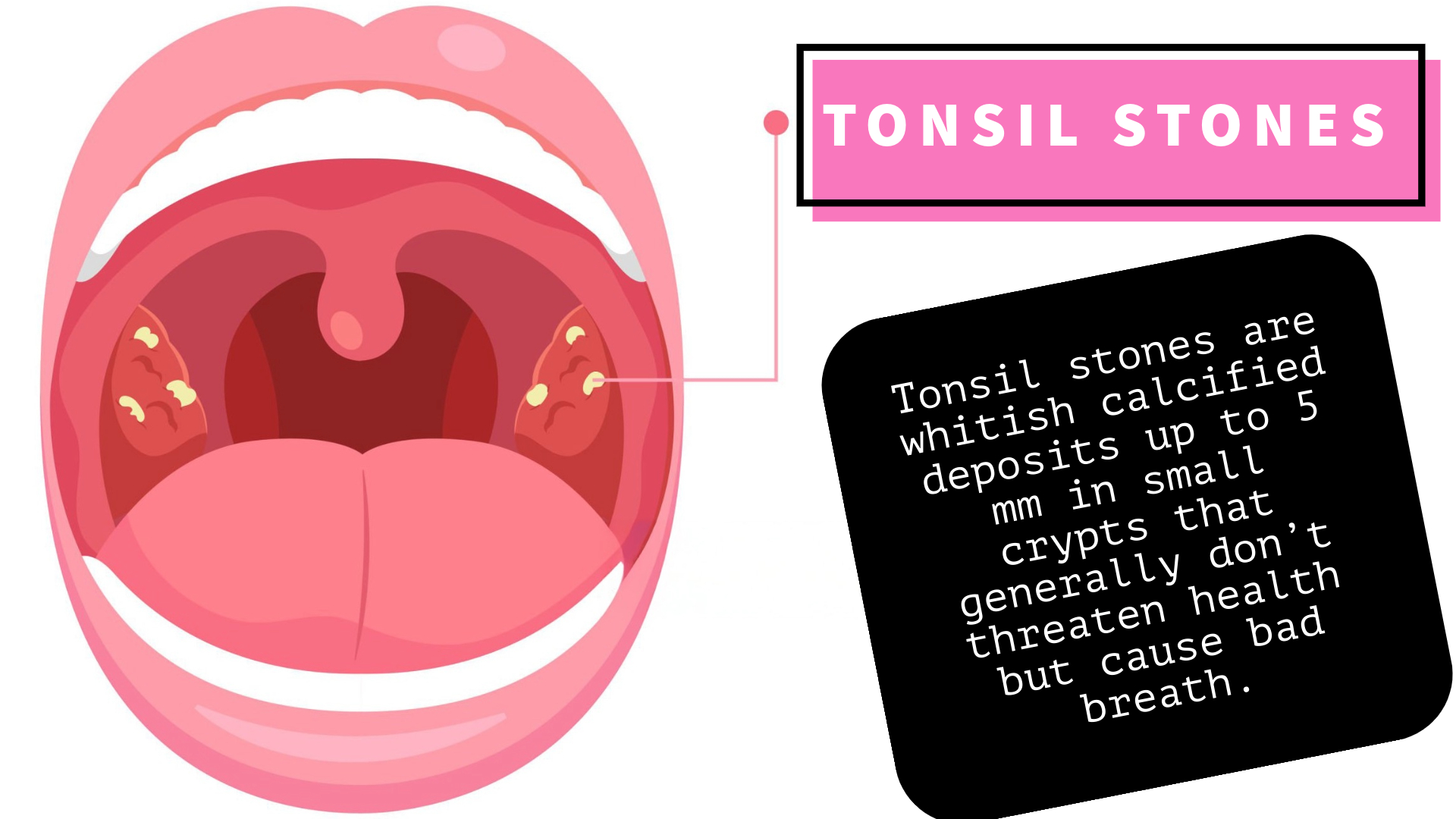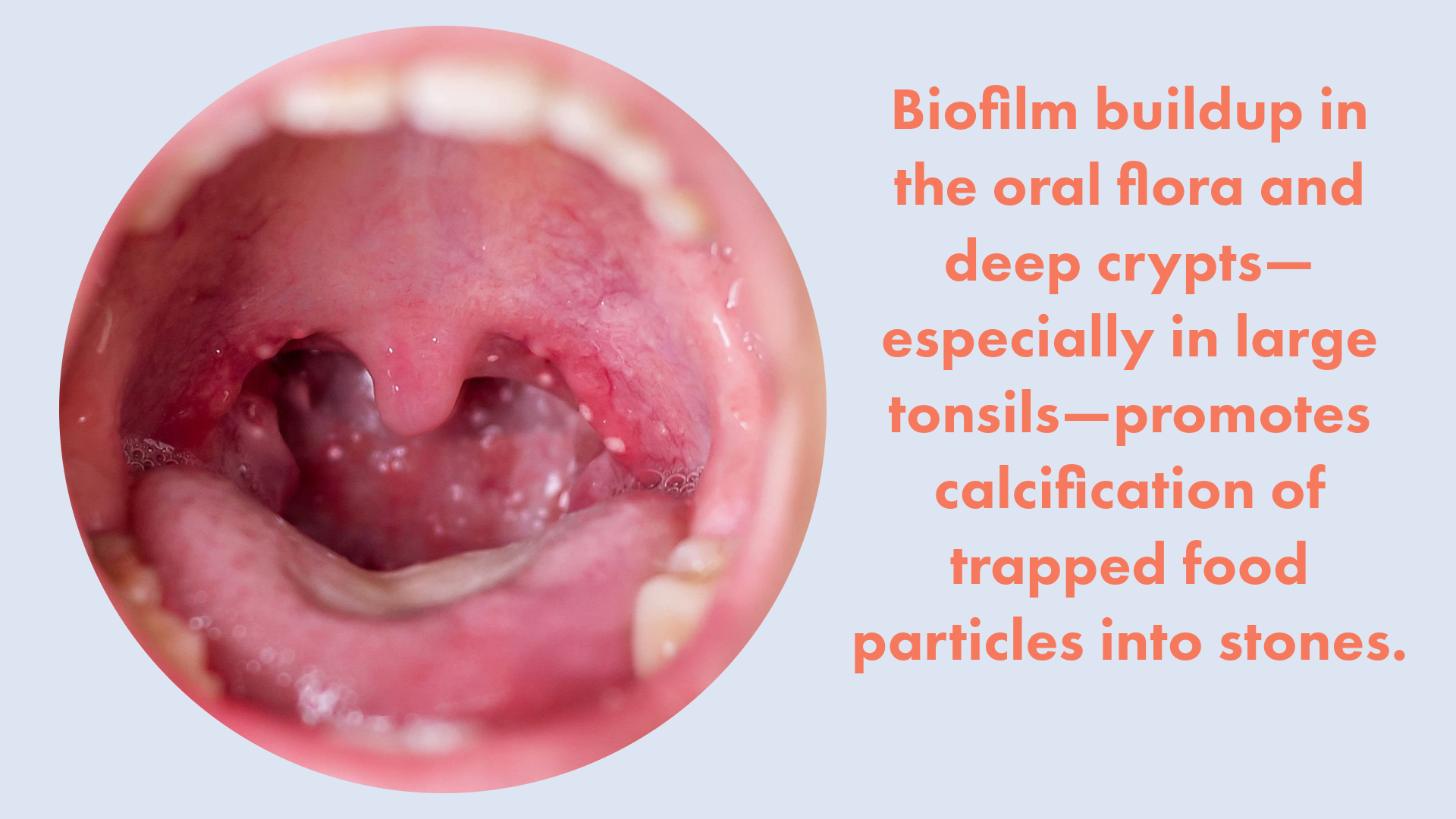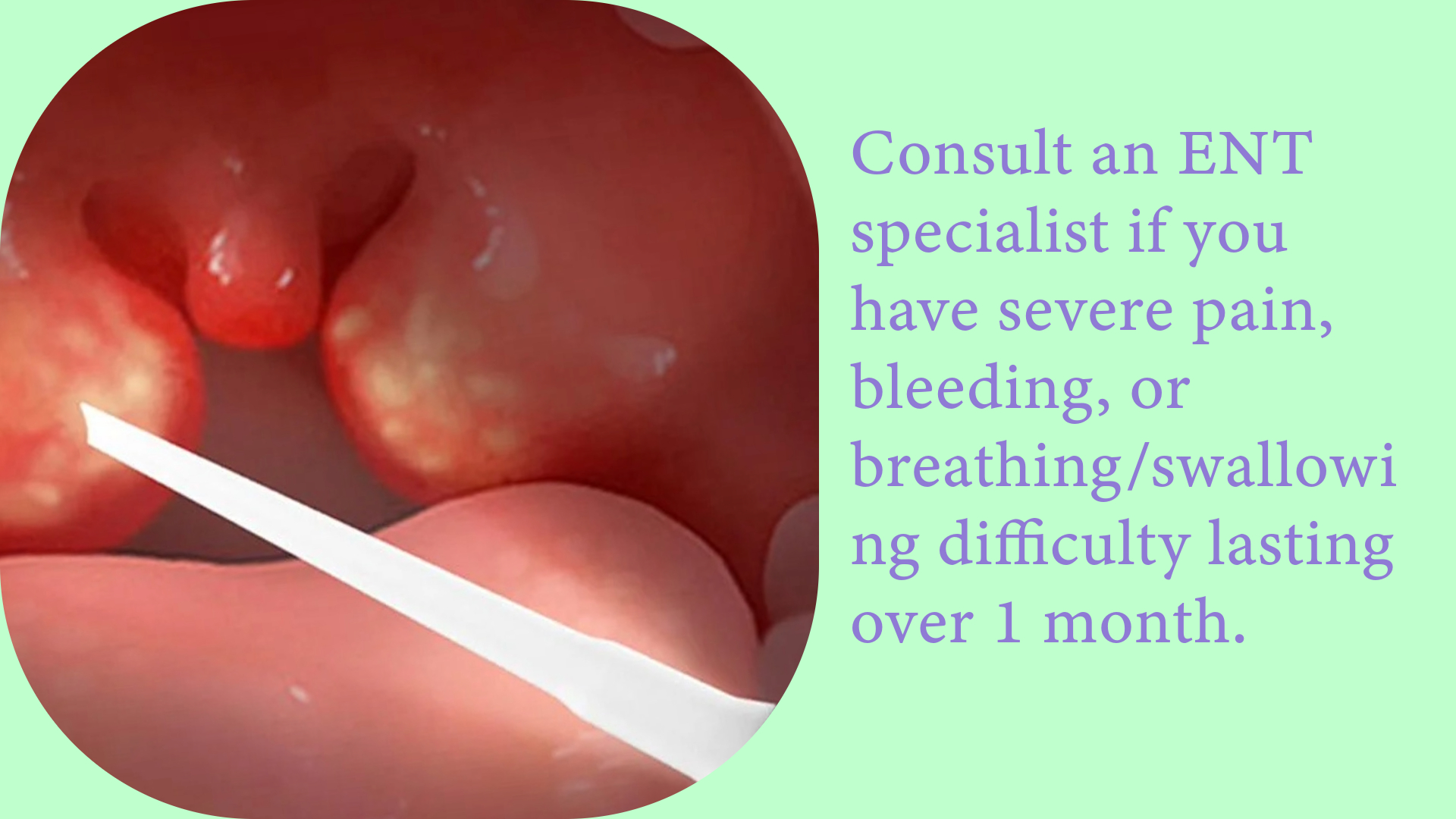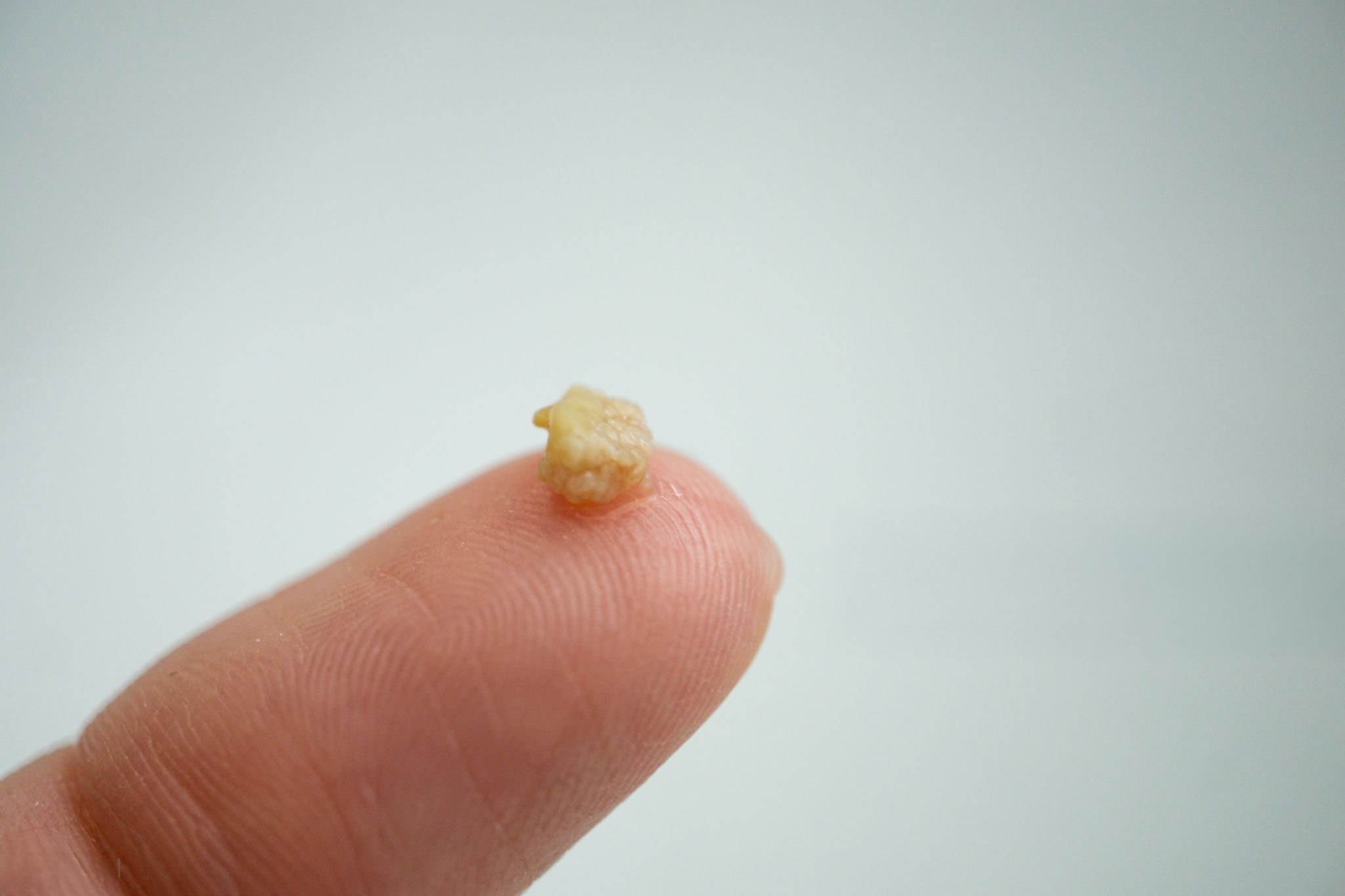Tiny, calcified objects called tonsilloliths develop when bacteria, food particles, and epithelial debris that builds up in the tonsils' recesses (crypts) mix with calcium and harden with time. Although these small, white or yellowish stones (often less than 5 mm in diameter) do not constitute a significant health danger, they can produce unsavory side effects like foul breath (halitosis), a feeling of something foreign in the throat, and sometimes trouble swallowing. Here we'll go over what causes tonsil stones, how to spot them early, how to remove them safely at home, and what medical options are available for treatment.

What is a Tonsil Stone?
On the surface of your tonsils there are small indentations called crypts. The main task of these indentations is to train your immune system by catching bacteria and viruses. However, sometimes these crypts catch different substances, such as food residues, dead cells, or bacteria. Over time, calcium builds up around these substances, hardens, and small stones called tonsil stones are formed. Tonsil stones, medically known as "tonsilloliths," can be pebble-shaped and typically have a whitish hue. Despite how unpleasant they are, they typically pose no danger to health. Conversely, one of the primary causes of foul breath is the bacteria that accumulate on these stones.
Why do tonsil stones develop?

Although the exact mechanism of formation of tonsil stones is not known exactly, it is thought that the "biofilm" (thin layer formed by microorganisms) formed by the mixture of bacteria and fungi in the mouth plays an important role in this process. Bacteria and other residues accumulated in the tonsil recesses harden over time; calcium phosphate accumulation occurs during this hardening process. Especially in people with large tonsils, the possibility of stone formation increases, as the recesses on the surface can be deeper and irregular.
In patients with large tonsils, food particles or mucus can easily become trapped in these crypts and calcify. In addition, people with frequent tonsillitis (tonsillitis) are likely to have an increased risk of stone formation after repeated infections, as the tonsils may swell with each infection, causing new recesses. In some people, mucus production and bacterial activity may be higher due to body chemistry, which makes it easier for the biofilm to thicken and turn into stones.
Habits that facilitate the formation of tonsil stones
Some factors that facilitate the formation of tonsil stones are as follows: Lack of regular oral hygiene, i.e. insufficient brushing and flossing, increases the risk of stones by increasing the accumulation of bacteria and debris in the mouth. Large tonsils or tonsils with large crypts also provide a favourable environment for stone formation. In patients with frequent nasal congestion due to chronic sinusitis, nasal discharge or allergic rhinitis, excessive mucus production, accumulation of this mucus in the tonsil recesses may support stone formation.
Insufficient fluid intake (dehydration), decreased saliva production due to dry mouth may also increase the risk of stones. In addition, habits such as smoking and alcohol consumption increase the susceptibility to stone formation by weakening the defences in the mouth. Changes in hormonal periods such as puberty can also sometimes trigger stone formation. In short, poor oral hygiene, mucus accumulation due to allergic or chronic infection, smoking/alcohol and insufficient hydration are the main factors that increase the risk of tonsil stones.
First Symptoms of Tonsil Stone

When tonsil stones are small, they don't cause much discomfort, but they progress slowly and quietly. Nevertheless, some typical signs indicate the presence of stones. The following indicators indicate the presence of tonsil stones:
- Bad breath: Bad breath that does not go away for a long time is the most common indicator of tonsil stones.
- Bad taste in the mouth: A sharp, nasty taste in the mouth is a common symptom.
- Sore throat or a feeling of irritation: Persistent mild pain or stinging, especially near the stones.
- Coughing or scratchy throat: Stones can feel like a plug in the throat and cause chronic coughing.
- Earache: A feeling of throbbing or fullness in the ears may occur through the nerve networks in the throat.
- Difficulty swallowing: Large stones may cause discomfort when swallowing; there may be a feeling of "something stuck in the throat".
- White-yellow spots on the tonsils: Stones sometimes become visible. Small deposits or stones, usually whitish or yellowish in colour, can be noticed in the tonsil crypts.
Tonsillitis and other throat issues can mimic some of these symptoms, but if you're also experiencing foul breath and a feeling like something is stuck in your throat, you might want to consider tonsil stones. Given the small size of the stones, it is important to be vigilant for any other symptoms that might indicate their presence.
How do tonsil stones trigger bad breath?
One of the most disturbing aspects of tonsil stones is that they cause foul breath. A large amount of bacteria accumulates on the surface of the stones, and these bacteria produce volatile sulfur compounds with a bad odor. The stones serve as a home for bacteria. Tonsillolite (tonsil stone) deposits support bacterial growth in the mouth and lead to halitosis (bad breath). Therefore, if there is a persistent bad odour in the mouth, tonsil stones should be considered as a possible cause. If the odour does not go away despite teeth cleaning, stones may be the source of the problem.
When Should You Seek Professional Help?

Tonsil stones can sometimes be treated at home in less complicated cases, but if any of the following happen, it might be best to visit an ENT specialist:
- Severe or chronic sore throat: Persistent sore throat or persistent inflammation lasting more than one month.
- Redness, swelling or bleeding of the tonsils: If such symptoms develop while trying to remove stones, it is necessary to consult a doctor to prevent them from getting worse.
- Difficulty swallowing or breathing: If the stones grow and block the way, swallowing or breathing may be uncomfortable.
- If the pain is severe or the stones are large: If the stones continue to grow despite home measures, it is necessary to seek professional intervention when the symptoms become unbearable.
- Frequent recurrent tonsillitis or untreatable infections: In patients with recurrent tonsillitis or infections that do not respond to conventional treatments, such as antibiotics, it is crucial to manage the infection with a specialist.
What are Professional Treatment Methods

Medical alternatives to surgery should be explored in cases where the stones are large or recur frequently. Procedures such as laser crypolysis or coblation crypolysis attempt to prevent stone formation by "flattening" the deep indentations on the surface of the tonsils. In these procedures, the crypts are corrected using laser or radio waves under local anaesthesia. The recovery time after the procedure is usually shorter and less painful than with conventional tonsillectomy. Research has shown that in certain cases, techniques like coblation can be an effective substitute for tonsillectomy.
Tonsillectomy: Pros, Cons and Recovery
Complete tonsillectomy, i.e. complete removal of the tonsils, is the most definitive solution against tonsil stones but should be considered as a last resort.
The advantage is that it eliminates problems by preventing stone formation at the root.
The disadvantages are the surgical risks and the recovery time. There may be a severe sore throat for a few days after the operation, difficulty swallowing, and a risk of bleeding. Clinical experience shows that recovery after tonsillectomy is shorter in children and may take a little longer in adults. For this reason, doctors usually do not recommend tonsillectomy only for calculi unless there is chronic tonsillitis or other serious causes. It may be necessary to consider this option if the stones recur very often and are large and painful enough to reduce your quality of life.
Methods for Risk-Free Removal
One of the simplest methods for removing tonsil stones at home is to use cotton swabs (ear cotton swabs). With clean hands or disinfected cotton swabs, in front of a well-lit mirror, you can gently apply pressure to the area where the stone is located with extremely gentle movements. The cough reflex may be triggered during this procedure, so stop immediately if bleeding or severe pain occurs after a few attempts. During the procedure, you should avoid scraping with hard objects (toothbrush handle, toothpick, etc.) and instead use soft-tipped instruments. For example, a water jet (oral irrigator) or soft-tipped cotton swabs can help dissolve the stones, reducing the risk of damaging the surface of the tonsil.
Here are some things to consider when removing tonsil stones at home:
- Be gentle: Pressing too hard can cause bleeding and infection. Try to release the stone by pushing only gently.
- Hygiene is essential: Wash the cotton swab or finger with soap beforehand, make sure it is clean.
- Observe the conditions: If your tonsils are red or bleeding, consult a doctor before trying this method.
Such applications can only be applied if the stone is small and prominent; if there is pain or bleeding, stop and consult a specialist.
Salt Water Gargle and Other Methods
Saltwater gargling is one of the simplest and most effective methods for removing tonsil stones. Add half to one teaspoon of salt to a glass of warm water and gargle for a few seconds, bringing this water into contact with the back of your throat. The salt water gently softens and loosens the stones and reduces the build-up of bacteria in the throat.
Another option is water irrigation. You can get a low-pressure water spray or oral irrigator (water flosser) and hold it against the crypts of the tonsils, gently pressing the instrument against the tonsil crypts while inhaling through your mouth rather than your nose. This method can gently wash and remove the stones.
Caution: The water jet can cause coughing when moving to the back of the throat; in children this method can be dangerous. Nevertheless, regular saline gargling and cleaning the tonsil recesses with water irrigation are very effective in preventing stone formation.
Effective use of oral hygiene products
Using proper oral hygiene products is essential for avoiding tonsil stones.
Flossing and brushing: The longer food remains in the mouth, the higher the risk of stones. Brushing twice daily and flossing, preferably after meals, reduces bacteria in the mouth.
Tongue cleaner: Bacteria on the surface of the tongue can also cause problems. Using a tongue cleaner during or after tooth brushing can balance the oral flora and reduce the risk of tonsil stones.
Mouthwash: Alcohol-free antiseptic mouthwashes kill germs in the mouth and slow down the formation of stones. A natural mint or sage mouthwash several times a week can also alleviate bad breath. In addition, low-pressure water-based tools such as water flossers can also clean the recesses around the tonsils better than floss. Scientific sources recommend using a cotton swab or water jet instead of a hard toothbrush. In conclusion, regular and correct oral hygiene both prevents the appearance of tonsil stones and reduces the symptoms.
Natural Remedies for Tonsil Stones
Some herbal remedies can alleviate the discomfort caused by tonsil stones.
Herbal teas and mouthwashes: Warm chamomile tea or sage reduces throat irritation. Similarly, mouthwashes made from herbs with high natural antiseptic properties, such as thyme and sage, can have a soothing effect. In addition, essential oils such as lavender, lemongrass or clove oil can be useful thanks to their antibacterial properties.
You can add a few drops of lavender oil to your toothbrush and brush your teeth, or add a drop of lavender or clove oil to your mouthwash (warm water). These oils help to reduce the bacteria that contribute to the formation of tonsil stones. Remember, pure essential oils should not be used directly, they must necessarily be diluted.
Diet
Diet also plays a role in the formation of tonsil stones.
Drink plenty of water: Drinking enough water prevents dry mouth and reduces mucus build-up. According to health sources, drinking 8 glasses of water a day can limit the formation of stones.
Probiotics: Foods containing probiotics, such as yoghurt, balance the oral flora and reduce the bacteria that form the basis of stones.
Vegetables and fruit: Eating raw carrots increases salivation, while acidic fruits such as apples can change the pH of the mouth and weaken bacteria. Similarly, getting enough vitamin C (e.g. oranges, lemons) can strengthen the oral tissues.
Mixed-fat or high-milk foods (e.g. whole milk and cheeses) can be reduced as they increase mucus production. Avoiding excessively sweet and processed foods also helps balance the flora. In short, a balanced diet, fresh vegetables and fruits, and sufficient water are effective in preventing recurrence of tonsil stones.
Quick Remedies for Tonsil Stones
Many products that alleviate tonzilillitis can be found in supermarkets and pharmacies. Mouth sprays, antiseptics, and menthol mouthwashes are products that offer short-term relief. Reducing the bacterial load with alcohol-free mouthwashes can alleviate the odour caused by stones. In addition, some tonsil sprays or lozenges (especially those with natural antiseptic ingredients) have a soothing effect by covering the throat. Even though these remedies won't get rid of the stones, they will alleviate the pain and burning that comes with them.
Cold Compress and Throat Soothing Tricks
One of the quick relief methods for emergencies is cold compresses and similar applications. Applying a cold water bag or ice pack to your neck reduces swelling and pain in the surrounding tissues. Hot herbal teas can also provide temporary relief by softening the throat. Especially a mixture of honey and lemon provides both antiseptic and softening effect; you can mix a teaspoon of honey in a glass of warm water and sip slowly. Teas with ginger, chamomile or linden also naturally relieve a sore throat.
In addition, humidifying the air in the room or inhaling steam to create a moist environment helps prevent a dry throat. Adequate rest and warm fluids are always recommended. In particular, cold compresses and warm herbal teas can relieve irritation around the tonsils in a short time.
Stones You Cannot See

Some tonsil stones may not be visible because they form in deep crypts or in more posterior tissues. In this case, if there are symptoms (bad breath, feeling of fullness in the throat, occasional cough, etc.), the presence of stones can only be confirmed by professional examination. When examining your throat, your doctor may "scrape" or observe the stones with special instruments. Dentists occasionally use imaging methods like X-rays or CT scans to detect tonsilloliths during routine check-ups. If no stones are seen despite typical symptoms, a specialist may need to examine the stone in detail.
What to do when home remedies are not enough
If the above methods do not give satisfactory results, it is time to seek medical help. If you are experiencing symptoms like severe pain, trouble swallowing, shortness of breath, or persistent high fever, it is crucial to contact your doctor without delay. See a specialist in otolaryngology (ear, nose, and throat) if your symptoms do not improve or stay the same after trying home remedies. Keep in mind that you might need to see a specialist if the tonsil stone is particularly big or keeps coming back. After conducting a thorough physical examination, your doctor will determine the best course of action, which may include surgery.
To sum up, tonsil stones are usually harmless and can be easily treated. Early intervention with the correct diagnosis both alleviates the symptoms and reduces the likelihood of recurrence. Although it is usually sufficient to take care of oral care and apply small home solutions, it is the safest approach to seek help from an ear-nose-throat specialist when necessary.
